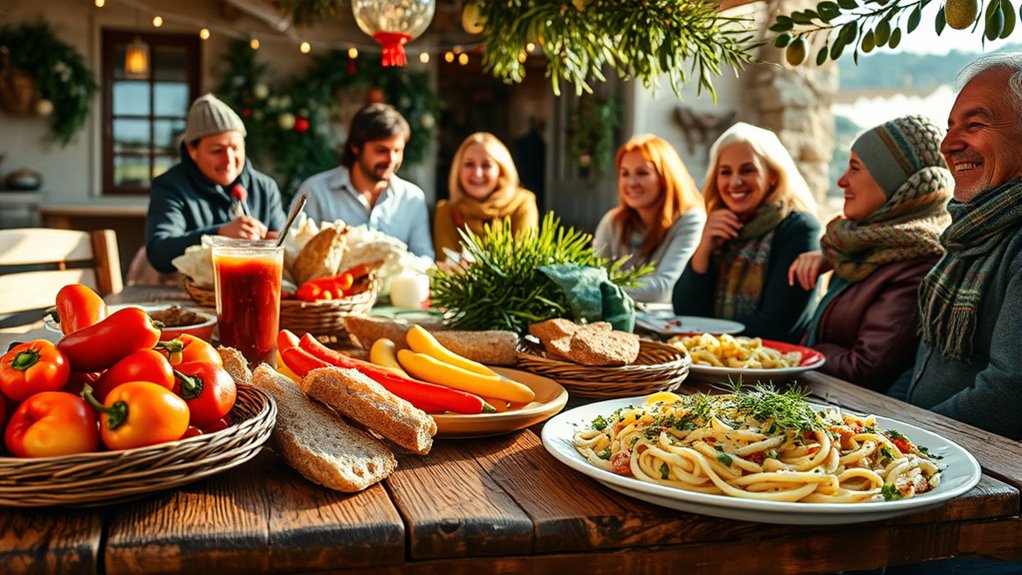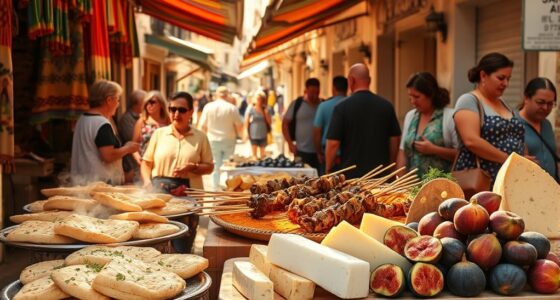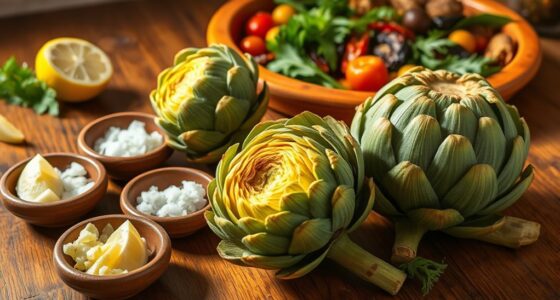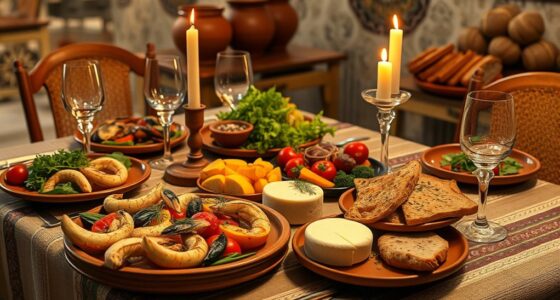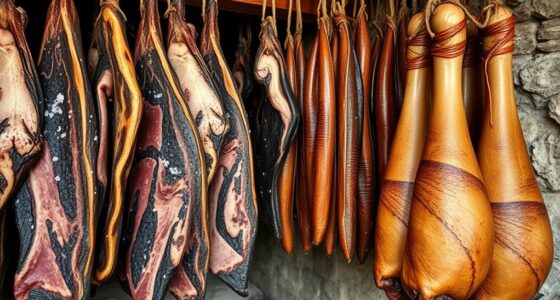During holidays in Ittiri, you’ll find a vibrant mix of traditional Sardinian dishes, sweets, and community celebrations. Local ingredients like sheep’s milk cheeses, honey, and fresh seafood take center stage in festive meals and desserts like Seadas and pistoccu. Festivals showcase harvests, seafood, and regional wines, fostering social bonds and cultural pride. If you want to discover more about these rich culinary customs and how they connect communities, keep exploring their festive traditions.
Key Takeaways
- Ittiri’s holidays feature traditional Sardinian dishes using local ingredients like sheep’s milk cheeses and honey.
- Festivals celebrate seafood, grapes, olives, and sweets like pistoccu, highlighting seasonal produce and community bonding.
- Seafood dishes such as grilled fish and shellfish are paired with Sardinian wines like Cannonau during festive events.
- Sweet treats like Seadas, Papassini, and Mustazzoleddus are prepared with honey, almonds, and chestnut flour, symbolizing local culture.
- Community gatherings emphasize sharing meals, preserving culinary recipes, and celebrating Ittiri’s rich gastronomic heritage.
The Rich Heritage of Holiday Foods in Ittiri

Ittiri’s holiday foods reflect a deep-rooted culinary heritage that combines local ingredients with age-old traditions. You’ll find sheep’s milk cheeses like Fresa, a specialty that preserves rustic flavors and plays a key role in festive dishes. Pecorino, made from Sardinian pastoral sheep, is prized for its rich flavor and health benefits, often paired with honey to symbolize unity. Honey from the strawberry tree, known as “Miele Amaro,” adds a distinct sweetness to desserts like Seadas, while saffron from Sardinia infuses vibrant color and aroma into celebratory foods. These ingredients form the foundation of signature dishes such as Culurgiones stuffed pasta and roast suckling pig. This culinary heritage emphasizes simple, fresh, and local ingredients, celebrating Sardinian pastoral bounty during holidays. Su Porcheddu, a traditional countryside dish of roast suckling pig, is often cooked on a spit for up to five hours, producing a crispy, delicious piece of meat that is a centerpiece of festive occasions. Additionally, traditional cooking techniques and rustic flavors are preserved through age-old recipes passed down through generations.
Seasonal Celebrations and Their Culinary Highlights

During seasonal celebrations in Ittiri, seafood festivals and local wine play a central role in the festivities. You’ll find fresh catches like sea urchins and shellfish paired with regional wines that enhance the flavors. Harvest time also brings traditional sweets and baked goods that highlight the area’s rich agricultural heritage. Sardinian cuisine is characterized by its emphasis on fresh, natural ingredients and rustic preparation methods, making these celebrations a true reflection of local culinary traditions. Additionally, many of these festivities showcase local ingredients that have been cultivated and caught for generations, preserving the authenticity of Sardinian food culture.
Seafood Festivals and Wine
Seafood festivals in Ittiri celebrate the island’s rich maritime heritage with vibrant events that highlight fresh, local fish and traditional Sardinian preparations. You’ll enjoy fried fish, grilled options, seafood salads, and shellfish dishes made from high-quality, locally sourced ingredients. These festivals, often part of larger cultural events like the Ittiri Folk Festa in July, take place in public gardens and town squares, fostering community participation. Complementing the seafood, local Sardinian wines like Cannonau and Vermentino are served extensively, emphasizing native grape varieties. Wine tastings and pairing events are common, enhancing the culinary experience. These celebrations not only preserve Sardinian culinary traditions but also boost local tourism and artisanal product exposure, creating a lively atmosphere that blends food, music, and cultural pride. The local culinary heritage plays a vital role in maintaining the authenticity and appeal of these events. Salude & Trigu Program also symbolizes well-being and abundance, adding cultural significance to these festive occasions.
Harvest and Traditional Sweets
Have you ever experienced the vibrant autumn harvest in Ittiri, where the air fills with the scent of ripe grapes, chestnuts, and olives? During this season, the town celebrates with festivals showcasing local produce and traditional sweets. You’ll find stone houses open, offering insights into Sardinian rural gastronomy and crafts. Chestnuts, grapes, and olives dominate the festivities, reflected in seasonal desserts like *pistoccu*, bread made with chestnut flour, honey, and almonds, and *sebada*, cheese-filled pastries drizzled with honey. These sweets connect deeply to religious observances and community bonds, often shared among neighbors. Family participation is essential, with recipes passed down and preserved through local workshops. These culinary traditions highlight Ittiri’s agricultural roots and cultural identity during its lively harvest celebrations. Incorporating traditional vacuum-sealing methods can help preserve some of these seasonal flavors and specialties for longer periods.
Traditional Sardinian Dishes and Ingredients in Festivities
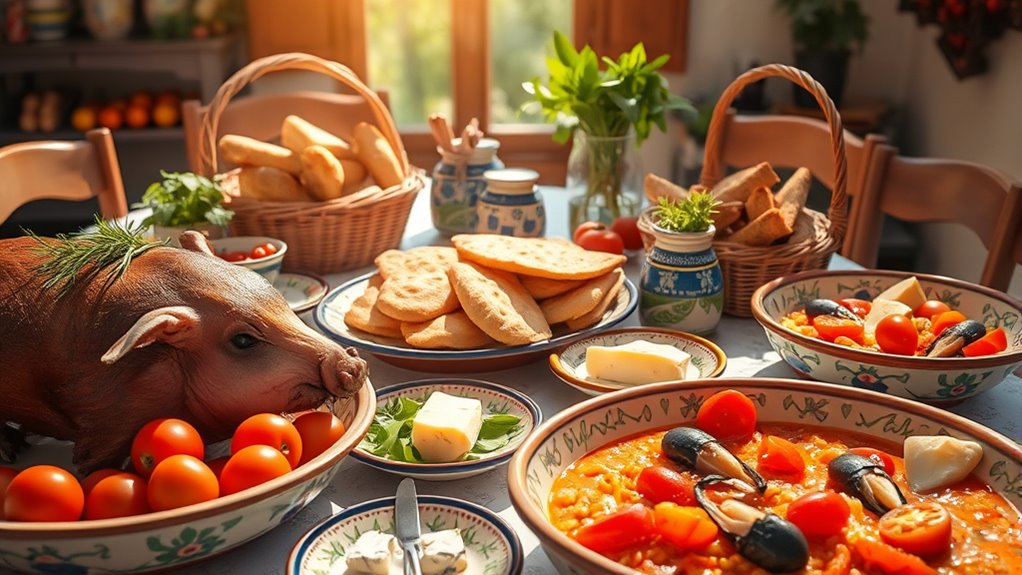
During festivities in Ittiri, you’ll notice how Sardinian staple ingredients like pecorino sardo cheese, aromatic herbs, and local olive oil play a central role in creating memorable dishes. Traditional recipes, such as ciccioneddus with lamb ragù or roasted suckling pig, highlight these ingredients’ rich flavors. These dishes showcase the region’s culinary heritage, emphasizing community and seasonal bounty.
Sardinian Staple Ingredients
Sardinian cuisine relies heavily on a few key ingredients that define its unique flavors, especially during festive celebrations. Durum wheat semolina is crucial for making pasta like fregula and malloreddus, giving dishes a hearty texture. Pecorino cheese adds a sharp, salty flavor to many recipes, such as pane frattau and gallurese soup. Seafood, including clams, mussels, and sea urchins, reflects the island’s coastal access and is prominent in dishes like fregula with clams. Lamb is also essential, often featured in traditional pastries like panada. Tomatoes are a staple, used to create rich sauces that enhance many festive dishes. These ingredients are often combined in traditional Sardinian dishes to create festive menus, highlighting the island’s rich culinary heritage. The use of local ingredients underscores Sardinia’s commitment to authentic flavors and sustainable practices. Together, these ingredients embody Sardinia’s culinary identity, blending land and sea influences into vibrant, memorable flavors during celebrations.
Festive Traditional Recipes
Festive celebrations in Ittiri showcase a rich array of traditional recipes that highlight the island’s culinary heritage. You’ll find hearty meat dishes like porcheddu, slow-roasted with myrtle leaves for crispy skin and tender meat, and cinghiale al sugo, flavored with herbs and spices. Easter features roast lamb with artichokes, stewed to perfection. These meats often accompany fresh vegetables, balancing richness. Emphasizing cultural traditions through food fosters cultural intelligence and strengthens community bonds.
| Dish | Key Ingredients | Occasion |
|---|---|---|
| Porcheddu | Suckling pig, myrtle leaves | Festive gatherings |
| Cinghiale al sugo | Wild boar, savory sauce | Hunting season |
| Roast lamb | Lamb, artichokes | Easter |
| Patate al forno | Potatoes, rosemary | All celebrations |
These recipes reflect Sardinian traditions, emphasizing local ingredients and communal joy.
Crafting Sweets and Pastries for Special Occasions
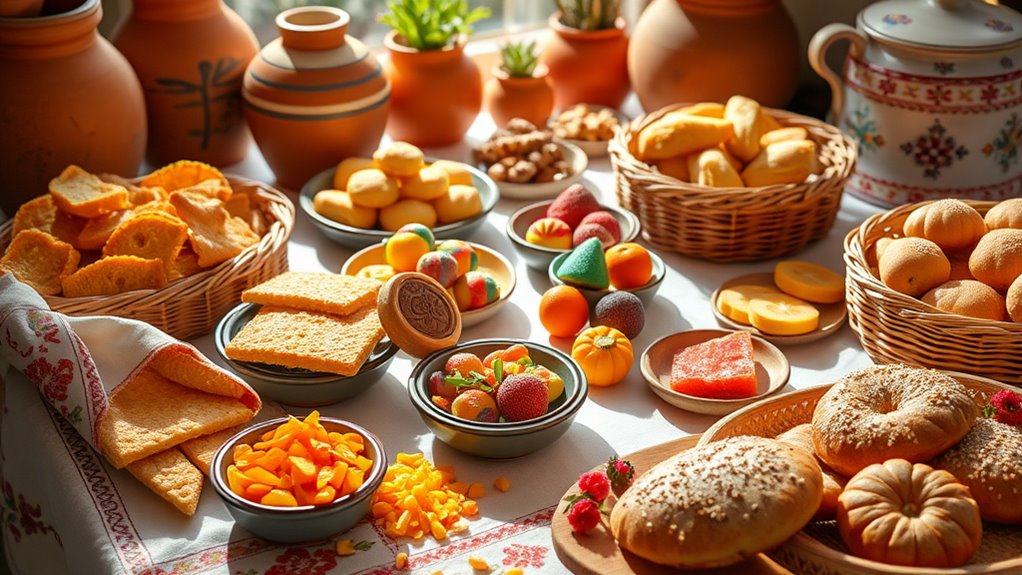
Crafting sweets and pastries for special occasions is a cherished tradition that showcases the rich culinary heritage of Ittiri. You’ll find that each treat has a unique purpose and symbolism. For example:
Creating traditional sweets for special occasions celebrates Ittiri’s rich culinary heritage and community spirit.
- Seadas are fried pastries filled with lemon-scented cheese, drizzled with honey, often enjoyed during festivals. Seadas are considered a symbol of Sardinian hospitality and are often shared among family and friends during celebrations.
- Papassini are almond-filled cookies decorated with sugar pearls, typically prepared for All Saints’ Day.
- Mustazzoleddus are almond biscuits topped with sugar icing, popular during Christmas.
These sweets are made with ingredients like almonds, honey, and lemon zest, highlighting Sardinian flavors. The techniques involve frying, baking, and decorating to enhance both taste and appearance. Each sweet plays a essential role in celebrating traditions and fostering community bonds during holidays.
The Role of Food and Drink in Community Gatherings

Food and drink play a central role in bringing the community together during gatherings, serving as more than just nourishment but as a way to foster social bonds. Meals are often shared in a circle, promoting equality and direct interaction. Traditional wooden dishes or cork platters highlight rustic, communal eating styles, while sharp knives replace cutlery, reflecting local customs. Sharing dishes during holidays reinforces community ties. The emphasis on fresh, seasonal ingredients is evident in the preparation of many traditional dishes, ensuring they are both flavorful and representative of the local environment. To keep you engaged, here’s a glimpse of typical foods and drinks:
| Dish/Drink | Description | Occasion |
|---|---|---|
| Porceddu | Roast suckling pig, symbol of festivity | Weddings, festivals |
| Culurgiones | Stuffed pasta with potato and cheese | Food festivals |
| Limoncello | Lemon digestif, enjoyed as a revitalizing end to meals | Holiday celebrations |
These practices embody the community’s culinary spirit.
Preserving Culinary Traditions Through Generations
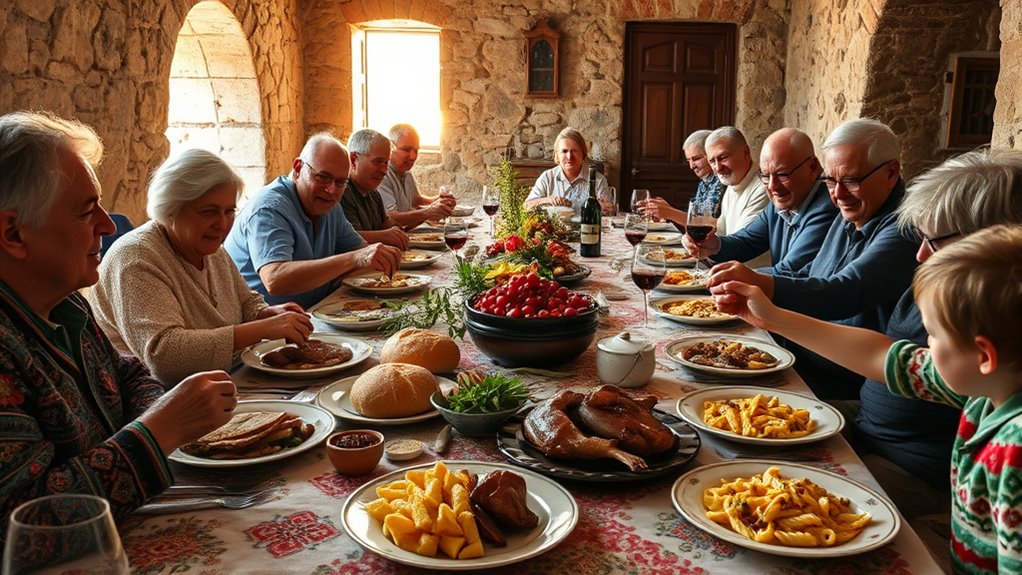
In Ittiri, culinary traditions are kept alive primarily through oral transmission, with elders passing down recipes and techniques directly to younger generations. You’ll notice that: 1. Recipes are shared informally in family kitchens during holidays, maintaining authenticity. 2. Skills like shaping traditional pasta, such as Ciccioneddos, are learned within small communities. 3. Storytelling accompanies cooking, linking recipes to cultural identity and celebrations. This oral knowledge preserves local dialect and culinary terminology, enriching Sardinian culture. Traditional ingredients like salting, drying, and fermenting are passed down, ensuring flavors and methods endure. The community’s commitment to passing down these techniques helps sustain culinary continuity across generations. Signature dishes like Porceddu highlight centuries-old recipes, while community bonding during holiday cooking reinforces these customs. Despite modern influences, local food movements and younger interest in revival help keep these culinary traditions alive, blending heritage with contemporary appreciation.
Frequently Asked Questions
How Do Local Ingredients Influence Ittiri’S Holiday Recipes?
You see how local ingredients shape holiday recipes in Ittiri. Pecorino cheese, honey, saffron, and fresh herbs like fennel and parsley add authentic flavors and nutritional value. Meats like roast suckling pig and wild boar reflect regional hunting traditions. Regional breads and sweets such as papassini and su Pan’e Saba enhance festive celebrations. Coastal ingredients like sea urchins and olive oil bring a fresh, maritime touch, creating rich, memorable holiday dishes.
What Are Unique Traditional Dishes Specific to Ittiri’S Festivals?
You’ll find that Ittiri’s festivals feature unique dishes like roasted suckling pig, highlighting Sardinian culinary traditions. Local cheeses such as pecorino and cured meats like salsiccia are common, often paired with traditional bread like pane carasau. Sweet treats like seadas and honey-flavored pastries also play a prominent role. These dishes are prepared communally, celebrating regional ingredients and cultural heritage during lively festivals filled with music, dance, and shared joy.
How Do Food Customs Vary Between Different Religious Celebrations?
You notice that food customs change with each celebration, highlighting cultural diversity and spiritual significance. During Saint Efisio, you carry portable foods reflecting pilgrimage needs. Easter emphasizes lamb and sweets symbolizing rebirth, while Christmas features festive pastries and roasted meats. San Giovanni celebrates local herbs and greens, emphasizing seasonality and protection. Each holiday’s foods tell a story, connect communities, and honor traditions, making your celebration richer and more meaningful.
Are There Specific Cooking Techniques Traditional to Ittiri Holidays?
You’re curious about traditional cooking techniques during Ittiri holidays. You’ll find slow-roasting of Porceddu, a whole suckling pig, is key; it’s cooked over wood fire or low-temperature ovens for hours, ensuring tender, smoky meat with crispy skin. You’ll also see dough-based dishes like Culurgiones crafted by hand, showcasing skill and community effort. Fried pastries like Seadas, filled with cheese and honey, highlight the balance of savory and sweet in festive meals.
How Has Tourism Impacted Ittiri’S Culinary Traditions?
Tourism has opened a window to Ittiri’s rich culinary world, like a bright lantern illuminating its flavors. You’ll see local festivals celebrating cheese and sweets, drawing food lovers from afar. This boost helps preserve traditions while encouraging innovation—sometimes blending old recipes with new twists. As you participate, you’ll notice how more farms and artisans thrive, making Ittiri’s cuisine a living, breathing heritage that evolves with every visitor’s experience.
Conclusion
Your journey through Ittiri’s holiday traditions reveals a culinary tapestry so rich, it could fill an entire world’s worth of stories. From age-old recipes to shared laughter over sweets, these traditions are truly the heartbeat of the community. By embracing and preserving these flavors, you help keep a heritage more vibrant than a thousand suns. Keep celebrating, tasting, and passing down these treasures — because they’re the soul of Ittiri, shining brighter with every generation.
